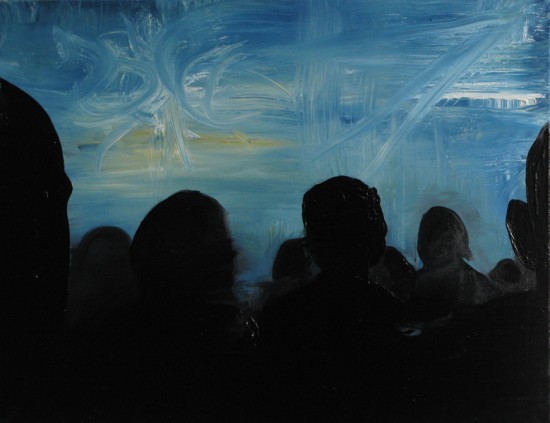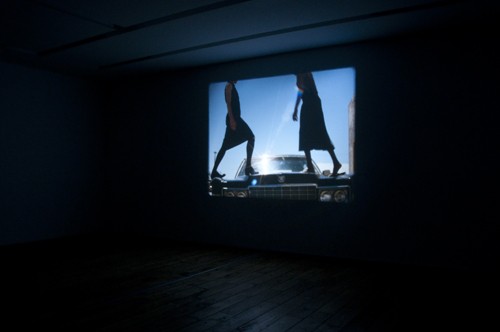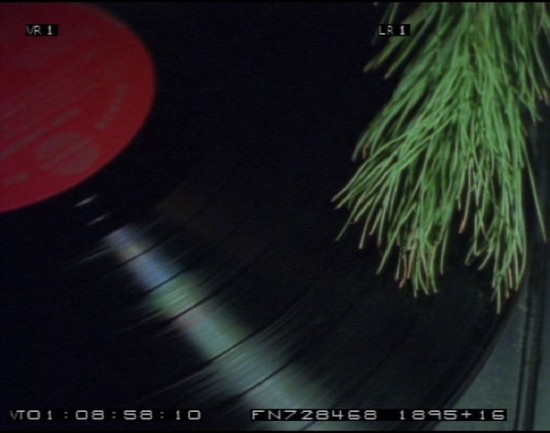Wilhelm Sasnal: Overturning the Everyday
By Akiko Kasuya
 Untitled (The Concert) (2009), oil on canvas, 70 x 55 cm.
Untitled (The Concert) (2009), oil on canvas, 70 x 55 cm.Wilhelm Sasnal was born in 1972 in Tarnów, a small city just outside Poland’s former capital, Kraków. After studying architecture at Kraków University of Technology, he transferred to the Kraków Academy of Fine Arts, from which he graduated in 1999. During his years as a student from 1995 to 2001, Sasnal participated in the artist group Grupa Ładnie. Working together with peers including Rafał Bujnowski (1974-) and Marcin Maciejowski (1974-), he focused on making paintings and drawings that explored how to transgress the boundaries between art and everyday life.
From early on, Sasnal chose familiar objects for his motifs, and he incorporated into his pictures the casualness and familiarity of the everyday. His simplification of form and use of bright colors can be associated with Neo-Pop Art; however, the social and political approach in his work can be traced to influences from the Łódź Kaliska group, famous for their radical and anarchist, yet humorous artistic activities under Poland’s former Communist regime. Sasnal’s focus on the ordinary and everyday also underscored the intimacy of his relationships with close friends. Even in their group activities, the Ładnie members were more concerned with their personal relationships than defining an artistic movement. The motifs they expressed, and the group name itself, meaning “beauty,” hinted at an agenda fraught with a certain degree of irony. Even after the group disbanded, its members have each maintained this basic approach in their individual practices.
Sasnal first gained international recognition as a painter around 2000, but in recent years his films have also attracted increasing attention. As Sasnal says himself, until 2004 he primarily exhibited only paintings and his films remained largely unseen (1). A key transition point occurred in 2006 when Sasnal was nominated for the Vincent van Gogh Biennial Award for Contemporary Art in Europe. For the exhibition of the nominees at Amsterdam’s Stedelijk Museum, Sasnal unexpectedly decided to show only his films. This adventurous move overturned preconceptions about Sasnal that had begun to take root and also signaled an important breakthrough in the artist’s career, as he went on to win the award. It also coincided with a period when recent developments in technology had led to a dramatic reduction in the size of video equipment and allowed functionally superior equipment to be obtained at relatively low cost, thereby creating an unparalleled influx of video works within the contemporary art world. However, rather than using video, Sasnal has consistently used 8mm and 16mm film cameras (which can be seen as a parallel to his use of the traditional paintbrush and canvas for his paintings) to produce sophisticated films that reflect the influence of music videos and integrate a psychedelic sensibility in depicting subjects such as the landscape and his family.
 Installation view of Marfa (2005), 16mm film, sound, 25 min.
Installation view of Marfa (2005), 16mm film, sound, 25 min.In the summer of 2007, as I was preparing for the “Still/Motion: Liquid Crystal Painting” exhibition that focused on the relationship between painting and film/video (2), I had the opportunity to research works from the “1, 2, 3 Avant-Gardes: Archives, Film, Art, Experimentation” exhibition held at Centre for Contemporary Art Ujazdowski Castle in Warsaw. Not only were Sasnal’s films deeply affecting in particular, but they also changed the way I look at his paintings. Sasnal’s paintings and films resonate in harmony with each other. For instance, the “painterly quality” of his films can be seen in his attention to texture and in his camerawork. The work that was being shown in Warsaw was Untitled (2000-06), which depicted vaguely silhouetted human figures moving slowly in time to pop music. I was moved by the work’s sense of ephemerality, its combination of poignancy with visual lushness, and could not stop watching.
Similarly, Sasnal’s installation of the three films Marfa (2006), Love Songs (2005) and Centre (2004) alongside a group of six paintings in his current exhibition at Tokyo’s Rat Hole Gallery, “16mm films,” is filled with tension, realizing a kind of alien world. Although his paintings were included in the exhibition “Essential Painting” at Osaka’s National Museum of Art in 2006, this is his first solo exhibition in Japan, and the first opportunity for audiences here to see his films and paintings together.
It should be noted that there are several historically significant examples of collaborations between music and film/video in Polish avant-garde film, such as Oko i ucho (The Eye and the Ear, 1945) – a brilliant combination of Karol Symanowski’s (1882-1937) music and the Surrealistic animation of Stefan and Franciszka Themerson (1910-88/1907-88). Alternatively, one can think of the various experiments by the Neo Avant-garde artists of the 1970s who used film to record the occurrences of daily life through the lens of a camera. In particular, one might recall the work of Józef Robakowski (1939-), who investigated themes related to private and everyday life and created several radical and humorous works that rebelled against the strict censorship of Communist rule at the time (3), and the pioneering artistic experiments of Natalia LL (1937-), known for making conceptual works in the 1970s.
 Still from Love Songs (2005), 16mm film, sound, 10 min. 1 sec.
Still from Love Songs (2005), 16mm film, sound, 10 min. 1 sec.As for Sasnal, while carrying forward the lineage of Polish Avant-garde and Neo Avant-garde art, he was also influenced (most likely through his education at the Kraków Academy of Fine Arts) by late 20th-century painters from Kraków such as Maria Jarema (1908-58) and Jerzy Nowosielski (1923-). Regarding the responsibility of addressing the tradition of painting, Sasnal’s view of his role as a painter is complex and ambiguous (4), but the “power to overturn” brought about by Sasnal’s sincere artistic activities is extremely significant in this complicated era when the existential meaning of art is continually in question. Moreover, both Sasnal’s paintings and film works, directly tied to the artist’s personal daily life, contain elements of Post-structuralism and references to Structuralism and Modernism, which are interlaced to deconstruct Minimalism and serve the role of placing the imagined object once more in the realm of reality. As a result, Sasnal’s work allows us to continually reinvent the relationship between ourselves and the everyday.
All images courtesy the artist, Anton Kern Gallery, New York, and Rat Hole Gallery, Tokyo.
-
Wilhelm Sasnal: “Lata Walki,” Zacheta Narodowa Galeria Sztuki, Warszawa, 2007/Galeria Civica di Arte Contemporanea, Trento, 2008
“Still/Motion: Liquid Crystal Painting,” Mie Prefectural Art Museum/The National Museum of Art, Osaka/Tokyo Metropolitan Museum of Photography, 2008
In Communist-ruled countries, only art based on Socialist realism could be officially exhibited. Poland was considered a relatively moderate regime compared to other Eastern Bloc states, but artworks that pertained to political contexts or showed any sign of expressing criticism of the Soviet Union were strictly censored, forbidden to be showed publicly and sometimes even confiscated or destroyed. For this reason, artists used sophisticated metaphors and analogies, and sometimes realist expressions associated with daily life, to demonstrate creativity in their artistic activities. They often exhibited in private apartments or basements so that only sympathetic individuals could see the work, and exhibition documentation was rarely made lest there remain any evidence of subversive activities that could be turned over to authorities. In order to reconstruct and verify facts from the time period, memories from the people involved, fragments of film, low quality document copies and handwritten notes that were secretly archived are currently being investigated.
See note 1.
